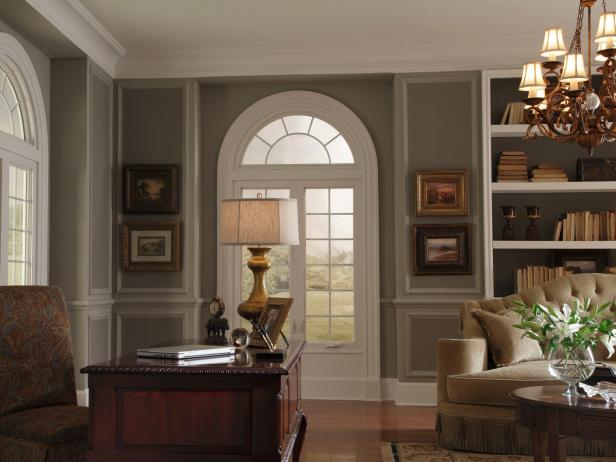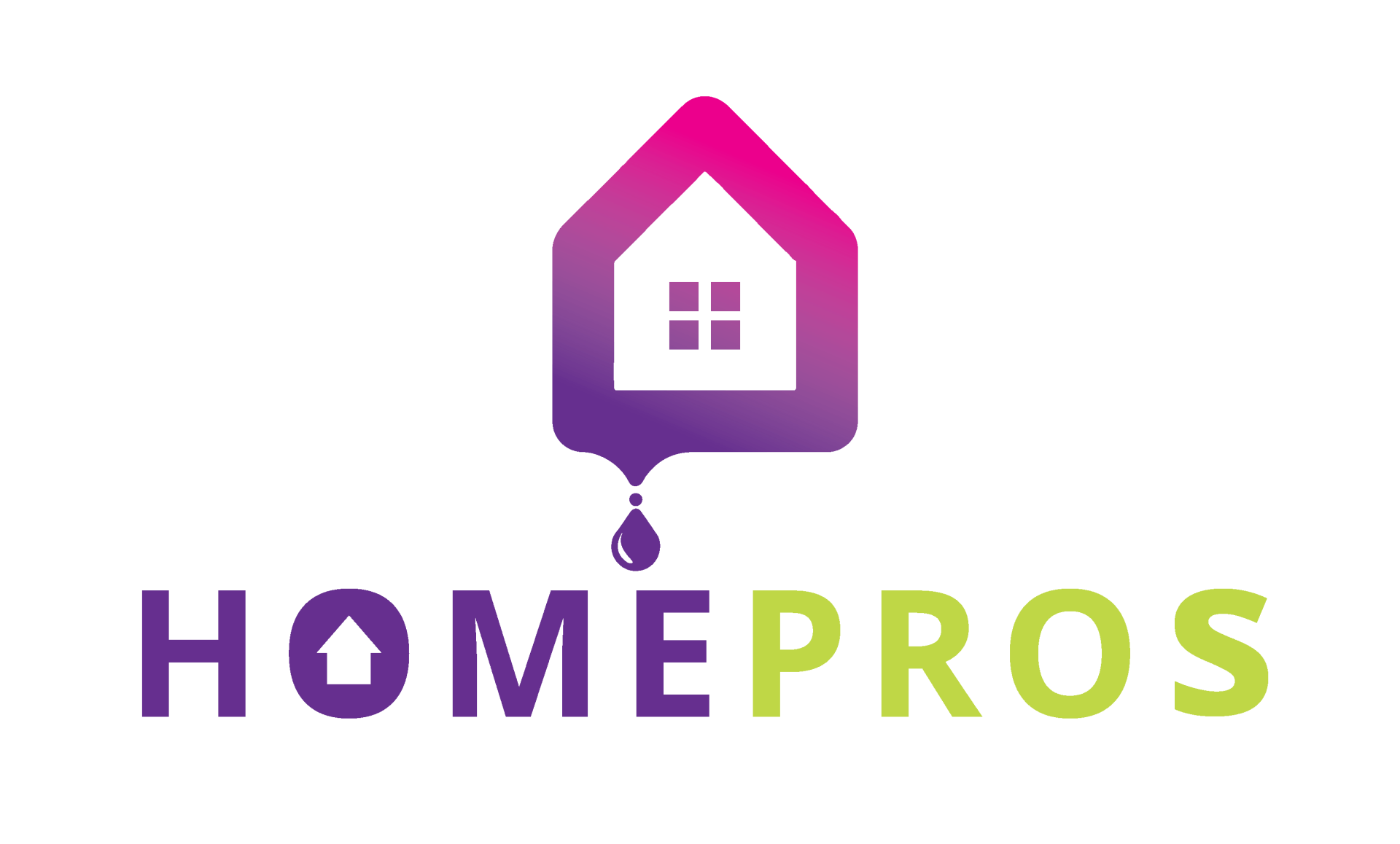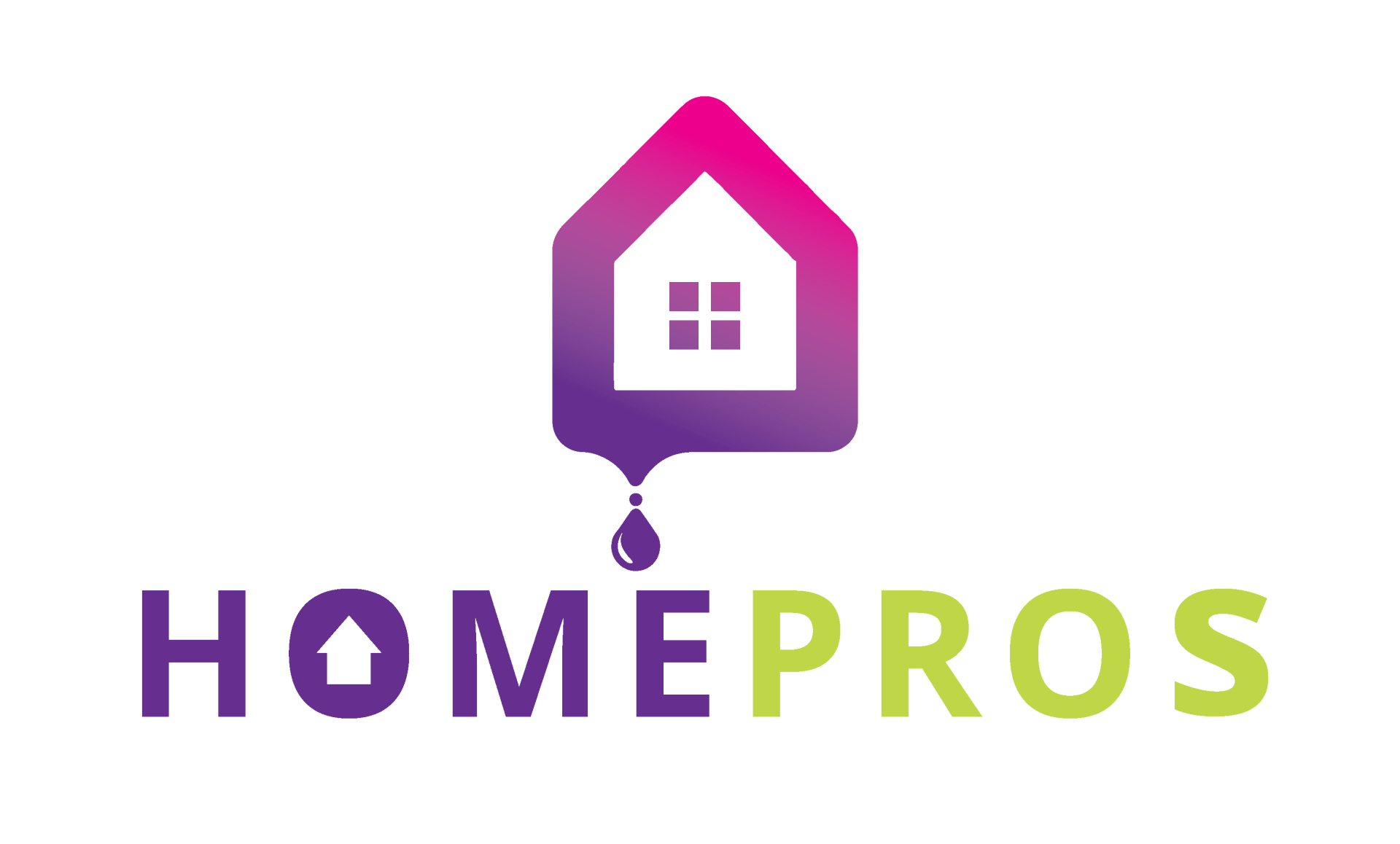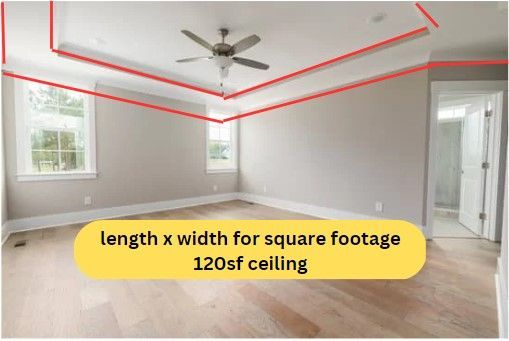What's the cost for painting
the interior of a house?

How much will my Olathe interior house painting cost?
According to Angi (formerly Angie’s List) “the average U.S. homeowner spends about $1949 to paint the interior of a house. Depending on square footage, most spend between $949 and $2950.”
According to the FORBES home website, the average cost to paint a house interior is “$1900 ranging from as low as $950 up to $2,900.”
Lastly, according to This Old House “If you hire interior painters to do the job for you, the national average cost can range between $1,800 and $10,000, based on the size of your home, the room being painted, surface type, and labor.”
Do these huge price ranges really help you in trying to get an idea of how much painting the interior of your home will cost? Why is there such a large spectrum between the low-end price and the high-end price?
If you were to do an online search for “interior painting pricing” you will find that most of the sites will re-use the same information. The truth of the matter is that the goal of these websites is to get you to land on their pages and then sell your data to painting company as leads.
If you want to get more precise pricing information you’ve come to the right place. At Home Pros Painting we want our customers to be “the most” educated consumers when it comes to painting their homes. For this reason, we are going to give you pricing information you will not find anywhere else.
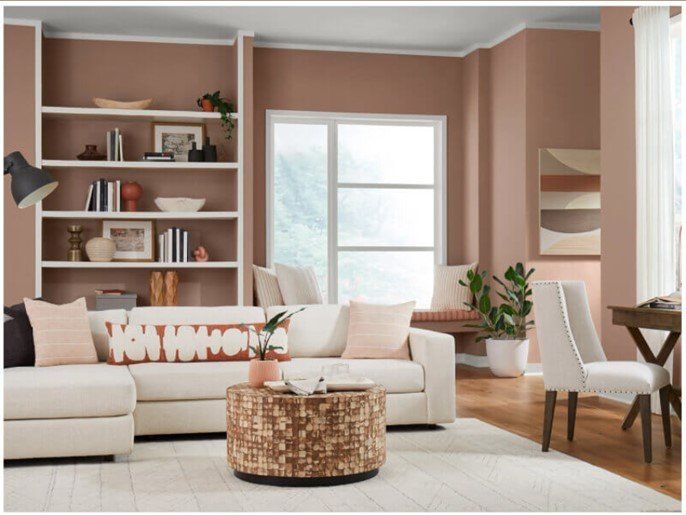
Why don’t painting companies publish their pricing?
When consumers conduct an online search for a product or service and are unable to find the price, it is extremely frustrating. With the advancements in online search technology, finding the price for painting the inside of a house shouldn't be hard.
Paint companies are reluctant to share this information because they do not want consumers or competitors to know. There is a fear they will lose business because of this pricing information being used against them.
How do painters come up
with their pricing?
Below are the most common methodologies used in the industry today.
Square footage pricing
This method involves calculating the total square footage of the interior surface to be painted and multiplying it by a per-square-foot cost.
Hourly pricing
This method involves charging a set hourly rate for the labor required to complete the project.
Time and materials pricing
This method involves charging for both the labor and materials used on the project, with costs for materials being based on actual costs incurred.
Fixed bid pricing
This method involves providing a fixed, lump-sum price for the entire project based on a detailed estimate of the work to be done and the materials required.
Cost plus pricing
This method involves adding a markup to the actual cost of materials and labor to arrive at the final price.
Walk through and throw a number
This method involves an estimator walking through the house and just throwing out figures. No measuring. No inquiring about your needs.
Home Pros Painting uses a combination of Square Footage Pricing, Lump Sum Pricing, and Linear Feet Pricing
As part of the Home Pros Painting methodology, every surface to be painted is calculated on a square foot basis. This means literally putting a tape measure (in our case a laser measure) on the entire house interior.
Every wall of every room gets measured. All the baseboards, chair rail, crown molding, and other trim get measured by the lineal feet. Things like doors, door casings, and window casings get counted individually and charged by the quantity.
How much will it cost to paint
my 2,000 square foot house?
It all depends on what you want painted inside the house. Are you wanting to only paint walls? Do you want to paint the trim also? How about the ceilings? What quality paint do you want to use?
When most homeowners inquire about painting interiors rooms, they typically are thinking floor square footage. Why is that? Because it’s the footage that is usually provided when buying and selling a home.
No one goes around measuring the walls and trim to figure out square footage when it’s time to do some painting.
On top of that, they don’t realize that besides drywall, the rooms have window casings, door casings, baseboards, ceilings, crown molding, chair rail, stair rails, built-in bookcases, vanities, wainscotting, and other similar wood surfaces that all have to be taken into account.
So, asking “how much to paint my 2000sf home” isn’t a specific enough question to even attempt to put pricing together. If someone throws out a price just based on that question, you need to be very cautious because they obviously aren’t taking everything into consideration.

How to calculate your
interior in 3 easy steps
1. Measure the Walls
Calculate the square footage of each wall section
2. Measure the Trim / Count Items
Calculate all trim pieces and count all doors and windows
3. Measure the Ceiling
Calculate the square footage of each ceiling section
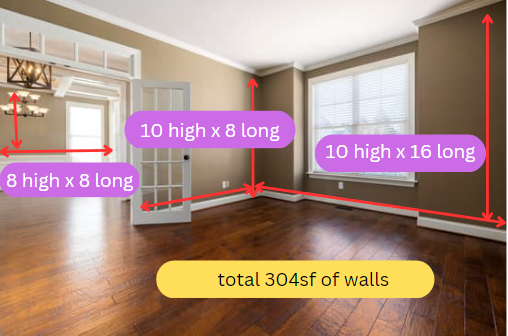
How to measure the walls a house
Our measurement process for houses is very simple. During the measurement, we measure both the length and height of each wall that’s to be painted. The process is repeated in every room of the house. For example, if the height of one wall is 10 feet and the length is 16 feet, the surface area of that wall would be 160 square feet (10 x 16 = 120). If you add the walls pictured below you would end up with 304sf.
What do I need to know about wall paint?
Wall paint, commonly known as interior paint, is specifically designed for use on the walls of a room. There are a variety of features that make wall paint different from other types of paint:
- Color: Wall paint comes in a vast range of colors, from neutrals to bold hues. The color can be customized to suit the desired look and style of the room.
- Finish: Wall paint comes in a variety of finishes, including flat, eggshell, satin, semi-gloss, and high gloss. The finish affects the look and durability of the paint, with high gloss offering the highest level of durability and shine, while flat paint provides a non-reflective finish
- Coverage: Wall paint is designed to provide excellent coverage over a large area with minimal coats, which saves time and money. The opacity of the paint, which refers to how much it hides the underlying surface, can vary depending on the type of paint and color sheen.
- Durability: Wall paint is formulated to be durable enough to withstand everyday wear and tear, as well as repeated cleaning. This is especially important in high-traffic areas such as hallways and living rooms.
- Application: Wall paint is formulated to be easy to apply with a brush, roller, or sprayer, and to dry quickly for fast and efficient painting. It is also important that the paint has low odor and VOCs (volatile organic compounds) for safe and comfortable application.
- Compatibility: Wall paint is designed to be compatible with a range of surfaces, including drywall, plaster, masonry, and wood. There are also specialty paints available for specific surfaces, such as bathroom and kitchen paints that are designed to resist moisture and humidity.
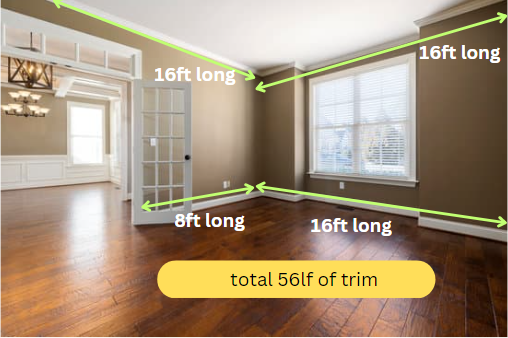
How to measure the trim and count the 'items'
When calculating trim, we measure baseboards, chair rail, crown molding, and wall stringers (that piece against the wall that the stair treads touch) by the lineal feet. Each type of trim ends up with its own line item so you can track the cost easily.
We measure common sized items by quantity. Things like window and door frames are counted and priced the same. Interior doors and closet doors are also counted individually. Occasionally someone will want to paint the actual window sashes and those are counted individually as each.
What about the paint used for the trim?
Interior trim paint is specifically designed for use on surfaces such as baseboards, window and door frames, crown moldings, which are commonly referred to as “trim” in interior design. Unlike standard wall paint, interior trim paint is formulated to provide a more durable and glossy finish that can withstand wear and tear, frequent cleaning, and exposure to moisture and humidity.
One of the key features of interior trim paint is its ability to dry to a hard, smooth, and non-porous surface that resists scuffs, scratches, and stains. This is achieved using high-quality resins and binders that form a tight bond with the surface, creating a protective barrier that is resistant to damage.

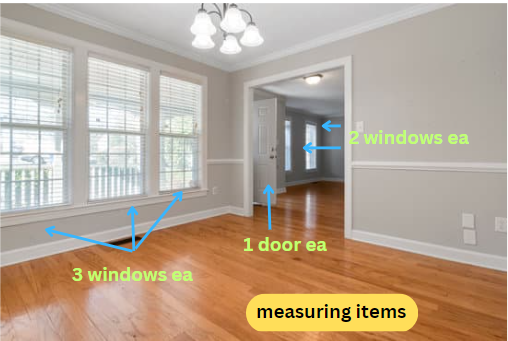
How to measure the ceiling
Our typical process to come up with the measurements of a ceiling is to calculate the surface area being painted. The surface area is then used to determine the amount of paint and labor needed to cover the ceiling.
To calculate the surface area of a ceiling, we need to measure the length and width of each section of the ceiling and multiply the two measurements together. For example, if the length of one section of the ceiling is 10 feet and the width is 12 feet, the surface area of that section would be 120 square feet (10 x 12 = 120).
If the ceiling has a simple rectangular shape, the painter can simply measure the length and width of the entire ceiling and multiply the two measurements together to get the total surface area. However, if the ceiling has a more complex shape or includes multiple levels, we may need to break it down into smaller sections and measure each section separately to get an accurate surface area measurement.
Once the surface area of the ceiling is calculated, we can use this measurement to determine the amount of paint needed for the job. Most paint manufacturers provide coverage estimates on the products, which can be used to determine the amount of paint required for a given surface area.
Is there a different paint for ceilings?
Interior ceiling paint is specially designed for use on the ceiling of a room, and there are several key features that make it different from other types of paint:
- Consistency: Ceiling paint has a thicker consistency than standard wall paint, which helps prevent drips and splatters during application.
- Coverage: Ceiling paint is formulated to provide excellent coverage with minimal coats. This is important, as the ceiling is often one of the largest surfaces in a room, and it can be difficult and time-consuming to paint multiple coats.
- Opacity: Ceiling paint is typically formulated with a high level of opacity, which means it hides imperfections and stains on the ceiling better than standard wall paint.
- Reflectivity: Ceiling paint is often formulated with a low level of reflectivity, which helps reduce glare and provides soft, even light in a room.
- Drying time: Ceiling paint is designed to dry quickly, which is important for avoiding drips and making the painting process more efficient.
- Sheen: Ceiling paint typically has a flat or matte finish, which helps hide imperfections and reduces the appearance of ceiling texture.
Overall, interior ceiling paint offers a variety of features that make it an ideal choice for painting the ceiling of a room. With its thick consistency, excellent coverage, and low reflectivity, it can help create a beautiful and even finish that enhances the overall look of a room.
How much does it cost
for each category?
How much does it cost to paint the walls?
In 2023, the cost of painting the walls of the house ranges from $0.70 to $1.00 per square foot for 2 coats of paint. Using the picture from the section above as an example, imagine that the total square footage comes out 304 square feet. This means that painting those walls will run from $213 to $304.
Wall painting on a full interior house painting project, with 3000 square feet of wall surface, would run between $2100 to $3000.
Other Costs:
Supplies - We consider supplies such as masking tape, masking plastic, masking paper, shields, tarps, garbage bags, and primers. There is good adhesive orange tape and standard yellow tape. There’s good masking plastic and there’s cheap masking plastic. Over the years, we've learned that buying cheap things doesn't pay off. For that reason, we don’t skimp on supplies.
The more surfaces we need to mask off (windows, decks, patios, roofs, etc.) the more supplies we will need. To simplify things, we typically charge $0.10 per square foot (unless the project is on the small side). Taking a 3400 square foot home as an example, the total amount would be $340.
Caulking - Painting the interior trim requires caulking to make things look smooth. Skimp on the quality of the caulk and it may eventually crack. We use the 2nd best residential caulking which has great expansion range. We include this in the trim paint pricing.
Heights
- Painting walls that are 18ft high is much more complicated than painting from a height of 8 feet. Painting from tall heights forces the painters to work slower and take more precautions. For this reason, we must add a small fee to account for this extra requirement. Typically, we just charge a flat $150 for the entire project.
How much does it cost to paint the trim and items?
The unit price to paint the baseboards, crown molding, and chair rails will range from $2.30 to $2.60 per square foot. If the total lineal footage of a house comes out 300 lineal feet, then that makes the total range $690 to $780.
The price for wainscotting, fireplace mantles, and other wall coverings will range from $2.60 to $4.00 per square foot. For 100 square feet, the price would come out to $260 to $400.
Interior doors are priced individually starting from $55 and can run up to $65. We count them all up and add them to the list of items to be painted. If the doors are to be removed from the hinges, to be sprayed out, then add another $20-$25 each.
Window casings are priced from $45 to $55 each, provided they are a standard size. In the event the windows are larger than standard, a higher price will be calculated.
Door casings are usually 17 lineal feet on each side of the door. We charge from $25 to $30 for each casing.
Closet bi-fold doors (or similar) run from $100 to $120. These types of doors
usually must be removed to be painted properly.
The interior side of entry doors
are commonly painted to match the trim in that room. These are usually the front entry and back entry doors. The price for these doors runs from $85 to $110.
How much does it cost to paint the ceiling?
The cost of painting the ceilings of a house ranges from $0.90 to $1.25 per square foot for 1 coat of paint. If the ceilings have a popcorn texture, then the paint has to be applied with a sprayer. If the texture is flat or knockdown, then they can be brushed and rolled.
Using the picture from the above section as a reference, imagine that the total square footage for that bedroom comes out 120 square feet. This means that painting that ceiling will run from $108 to $150 for that room. Now imagine that a full interior house could easily have 1800 square feet of ceiling to be painted. That means a full interior
ceiling
paint project could run between $1600 to $2250.
Summarizing All Costs -
The Grand Total
We'll use the figures provided above, for our sample house, and add up the total cost for a full interior paint project.
For our sample home, the cost would be $5,060 total on the low-end and $6,720 on the high-end.
All of the information we have provided here is dynamic, which means it can change based on the complexity of a home. As a result of the different grades of paint that we offer, most projects fall somewhere in the middle of these ranges.
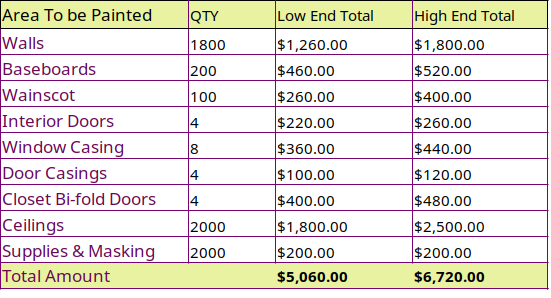
Last, but definitely not least
"The Warranty"
There is no doubt that price matters (it's not the only consideration, but it's still an important one). Last but not least is the warranty behind the work.
All Interior Paint Projects come with a standard 2-Year Warranty.
We hope to have provided you with a better understanding of what it might cost to paint the interior of your home. We are happy to provide you with a firm fixed price for your next painting project.
Schedule Your No-Obligation, No-Pressure Estimate Today!
HERE IS WHY WE ARE THE BEST CHOICE:
We know painting the interior of your home is a huge deal. That's why you don't pay until the work is completed.
We have a proven record of performing good work. Don't take our word for it, check out our Google Reviews.
We are a local company Veteran owned and run. Your support stays in our community and not to some franchise corporation in another state.
We are licensed, insured, and aren't afraid to come visit our project a year later.
We are so confident in our workmanship that we offer a 2 year standard warranty on interiors. This is best in our area.
